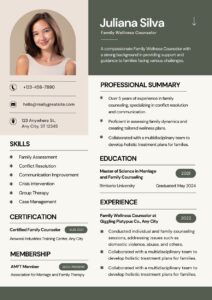Ensuring your Resume ATS-Friendly can make all the difference in securing an interview. Applicant Tracking Systems (ATS) are software tools employers use to filter resumes and select the best candidates. If your resume isn’t optimized for these systems, it might not even be seen by human eyes. This complete guide will help you craft an ATS-friendly resume that stands out. If your resume isn’t optimized for these systems, it might not even be seen by human eyes.
Understanding ATS: What It Is and Why It Matters
An Applicant Tracking System (ATS) is a software application used by employers to streamline the hiring process. With the influx of job applications for each opening, companies rely on ATS to efficiently manage and sort through resumes to identify the most qualified candidates. These systems filter applications based on set criteria such as keywords, skills, experience, and education.
Why does ATS matter? The answer is simple: your resume often passes through an ATS before it ever reaches a human recruiter. If your resume isn’t optimized for these systems, it can easily get lost in the shuffle, no matter how qualified you are for the position. Understanding how Resume ATS-Friendly works and tailoring your resume accordingly is crucial for ensuring it gets seen by the right people.
ATS software scans resumes for specific keywords and phrases related to the job description. It parses resumes into a digital profile to make the information searchable and comparable to other applicants. This means that even if you have the perfect experience and skills for the job, an ATS might only recognize this if your resume is formatted and worded correctly.
How to Know if Your Resume is ATS-Friendly
Making sure your resume is ATS-friendly is crucial for getting past the initial screening processes. Here are key strategies to check if your resume is optimized for Applicant Tracking Systems:
1. Use Standard Fonts and Formats
ATS systems often struggle with non-standard fonts and formats. Stick to common fonts like Arial, Times New Roman, or Calibri. Avoid using images, graphics, or unusual layouts that could confuse the system.
Tip: Convert your resume to plain text to see how it looks. If the text is jumbled or sections are missing, an ATS might have trouble reading it.
2. Incorporate Relevant Keywords
ATS software scans for specific keywords related to the job description. Include relevant keywords throughout your resume to match the job requirements.
Example: If you’re applying for a software engineer role, include terms like “Java,” “Python,” “software development,” and “coding” if they are mentioned in the job posting.
Tip: Use variations of keywords, including both the acronym and the full term (e.g., “SEO” and “Search Engine Optimization”).
3. Stick to Standard Headings
Use conventional headings such as “Work Experience,” “Education,” “Skills,” and “Certifications.” ATS systems are designed to recognize these headings and categorize information accordingly.
Tip: Avoid creative headings like “My Journey” or “Professional Path” as they might not be recognized by the ATS.
4. Avoid Complex Formatting
Tables, columns, and text boxes can confuse ATS software. Stick to a single-column format without embedded images or graphics.
Tip: Use simple bullet points to list your responsibilities and achievements clearly.
5. Save in the Right File Format
While PDFs are often preferred for manual review, not all ATS systems can read them accurately. Save your resume in a .doc or .docx format unless the job posting specifies otherwise.
Tip: Always check the job posting for any specific instructions on resume format.
6. Test Your Resume with an ATS Checker
Several online tools can analyze your resume for ATS compatibility. These tools simulate how an ATS reads your resume and provides feedback on improvements.
Example: Websites like Jobscan or Resunate offer ATS resume checkers that compare your resume against job descriptions and provide a match rate.
7. Review for Spelling and Grammar Errors
Spelling mistakes and grammatical errors can prevent an ATS from accurately parsing your resume. Ensure your resume is error-free to avoid misinterpretation by the system.
Tip: Use tools like Grammarly or the built-in spell checker in your word processor to review your resume.
8. Tailor Your Resume for Each Application
Customize your resume for each job you apply for by aligning your skills and experience with the job description. This increases the chances of your resume being flagged as a strong match by the ATS.
Example: If a job posting emphasizes project management skills, ensure those skills are prominently featured in your resume.
Tip: Keep a master resume and tweak it for each application to highlight the most relevant experience and skills.

How to Create an ATS-Compliant Resume in 5 Steps
Creating an ATS-compliant resume is essential to ensure it passes through Applicant Tracking Systems and reaches hiring managers. Here are five steps to help you craft a resume that meets ATS requirements:
Step 1: Choose a Simple, Clean Format
Keep It Simple: Use a straightforward, clean format without fancy designs, graphics, or images. ATS systems often struggle with complex formatting.
Tips:
- Stick to standard fonts like Arial, Times New Roman, or Calibri.
- Use a single-column layout.
- Avoid tables, columns, and text boxes.
Example: John initially used a resume with multiple columns and graphics. After simplifying it to a single-column format with clear headings, his resume started passing through ATS filters.
Step 2: Use Standard Headings
Standardize Your Sections: Use conventional headings that ATS systems recognize, such as “Work Experience,” “Education,” “Skills,” and “Certifications.”
Tips:
- Clearly define each section with bold headings.
- Avoid creative or unconventional headings like “My Journey” or “Career Highlights.”
Example: Mark changed his resume headings from creative titles to standard ones and noticed an increase in interview invitations.
Step 3: Incorporate Relevant Keywords
Keyword Optimization: Extract keywords from the job description and incorporate them naturally into your resume. This helps the ATS match your resume with the job requirements.
Tips:
- Include job-specific terms and skills.
- Use both acronyms and their full forms (e.g., “SEO” and “Search Engine Optimization”).
Example: Sarah tailored her resume for a data analyst position by including keywords like “data visualization,” “SQL,” and “statistical analysis,” which were highlighted in the job description.
Step 4: Focus on Relevant Experience and Skills
Highlight Relevant Information: Prioritize your most relevant experience and skills that align with the job you’re applying for. Use bullet points to list achievements and responsibilities.
Tips:
- Quantify your achievements (e.g., “Increased sales by 20% in six months”).
- Emphasize key skills and experiences that match the job description.
Example: Emma focused her resume on her project management skills when applying for a project manager role, leading to a higher success rate with ATS.
Step 5: Save Your Resume in the Right Format
Choose the Correct File Format: While PDFs are popular, not all ATS systems can read them accurately. Save your resume in a .doc or .docx format unless specified otherwise in the job posting.
Tips:
- Follow the instructions in the job posting regarding file format.
- Avoid using formats like PDFs or images unless explicitly requested.
Example: Chris initially submitted his resume in PDF format, but after switching to .docx, he noticed an improvement in responses from employers.
Conclusion
Creating an ATS-compliant resume is a crucial step in today’s job application process. By following these five steps—choosing a simple, clean format, using standard headings, incorporating relevant keywords, focusing on relevant experience and skills, and saving your resume in the right format—you can significantly increase your chances of passing through Applicant Tracking Systems and getting noticed by hiring managers.
Remember, the goal is to make it as easy as possible for the ATS to read and understand your resume, while showcasing your qualifications and achievements. By optimizing your resume for ATS, you ensure that your skills and experience are accurately represented, giving you a better shot at securing interviews and landing the job you want. Start implementing these strategies today and take the first step toward your next career opportunity.
Key Takeaways:
- Simplify your resume format to ensure it can be read by ATS.
- Optimize your resume with relevant keywords extracted from job descriptions.
- Use standard headings and focus on relevant experience to enhance your resume’s ATS compatibility.
- Tailor your resume for each job application and include a skills section to highlight your strengths.
- Save your resume in a .doc or .docx format to ensure ATS readability.
Frequently Asked Questions (FAQs)
1. What is an Applicant Tracking System (ATS) and why do companies use it?
Answer: An Applicant Tracking System (ATS) is a software application used by employers to manage and streamline the recruitment process. It helps in sorting, filtering, and ranking job applications based on set criteria such as keywords, skills, experience, and education. Companies use ATS to efficiently handle large volumes of applications and identify the most qualified candidates quickly.
2. How can I make sure my resume is ATS-compatible?
Answer: To make your resume ATS-compatible, use a simple, clean format without images or graphics, and stick to standard fonts like Arial or Times New Roman. Incorporate relevant keywords from the job description, use standard headings like “Work Experience” and “Skills,” and save your resume in a .doc or .docx format. Tailor your resume for each job application to align closely with the job requirements.
3. Why is it important to use relevant keywords in my resume?
Answer: Relevant keywords are crucial because ATS software scans resumes for specific terms related to the job description. Including these keywords increases the chances of your resume being identified as a strong match for the position. This helps ensure that your application gets past the initial ATS screening and is seen by human recruiters.
4. Can I use a PDF format for my resume?
Answer: While PDFs are often preferred for their consistent formatting, not all ATS systems can read them accurately. It’s safer to use a .doc or .docx format unless the job posting specifically requests a PDF. Always follow the instructions in the job posting regarding the preferred file format.
5. How do I know if my resume has passed through an ATS successfully?
Answer: It’s challenging to know for sure if your resume has passed through an ATS unless you receive a response from the employer. However, you can increase your chances by following best practices for ATS optimization. Additionally, you can use online ATS checker tools like Jobscan or Resunate to see how well your resume aligns with the job description and get feedback on improvements.
